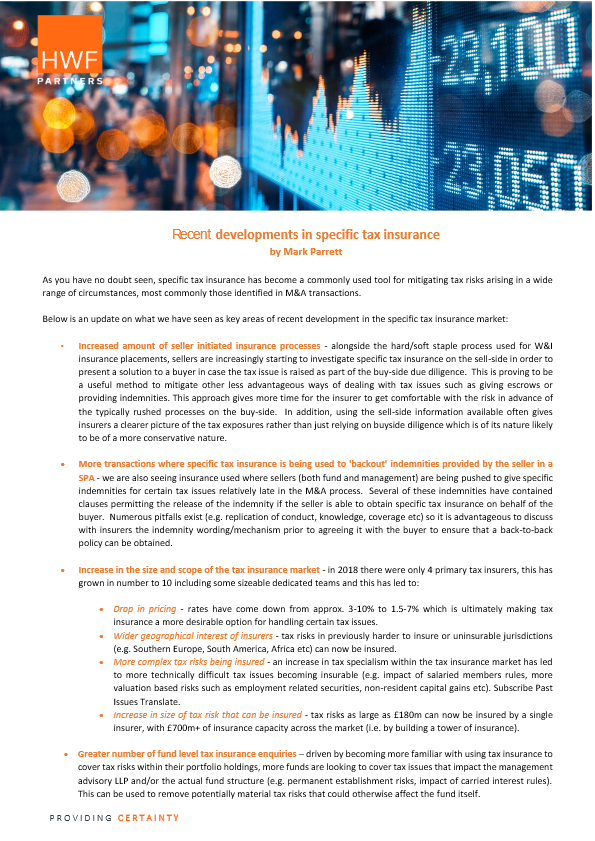Recent developments in specific tax insurance
As you have no doubt seen, specific tax insurance has become a commonly used tool for mitigating tax risks arising in a wide range of circumstances, most commonly those identified in M&A transactions.
Below is an update on what we have seen as key areas of recent development in the specific tax insurance market:
- Increased amount of seller initiated insurance processes – alongside the hard/soft staple process used for W&I insurance placements, sellers are increasingly starting to investigate specific tax insurance on the sell-side in order to present a solution to a buyer in case the tax issue is raised as part of the buy-side due diligence. This is proving to be a useful method to mitigate other less advantageous ways of dealing with tax issues such as giving escrows or providing indemnities. This approach gives more time for the insurer to get comfortable with the risk in advance of the typically rushed processes on the buy-side. In addition, using the sell-side information available often gives insurers a clearer picture of the tax exposures rather than just relying on buyside diligence which is of its nature likely to be of a more conservative nature.
- More transactions where specific tax insurance is being used to ‘backout’ indemnities provided by the seller in a SPA – we are also seeing insurance used where sellers (both fund and management) are being pushed to give specific indemnities for certain tax issues relatively late in the M&A process. Several of these indemnities have contained clauses permitting the release of the indemnity if the seller is able to obtain specific tax insurance on behalf of the buyer. Numerous pitfalls exist (e.g. replication of conduct, knowledge, coverage etc) so it is advantageous to discuss with insurers the indemnity wording/mechanism prior to agreeing it with the buyer to ensure that a back-to-back policy can be obtained.
- Increase in the size and scope of the tax insurance market – in 2018 there were only 4 primary tax insurers, this has grown in number to 10 including some sizeable dedicated teams and this has led to:
- Drop in pricing – rates have come down from approx. 3-10% to 1.5-7% which is ultimately making tax insurance a more desirable option for handling certain tax issues.
- Wider geographical interest of insurers – tax risks in previously harder to insure or uninsurable jurisdictions (e.g. Southern Europe, South America, Africa etc) can now be insured.
- More complex tax risks being insured – an increase in tax specialism within the tax insurance market has led to more technically difficult tax issues becoming insurable (e.g. impact of salaried members rules, more valuation based risks such as employment related securities, non-resident capital gains etc). Subscribe Past Issues Translate.
- Increase in size of tax risk that can be insured – tax risks as large as £180m can now be insured by a single insurer, with £700m+ of insurance capacity across the market (i.e. by building a tower of insurance).
- Greater number of fund level tax insurance enquiries – driven by becoming more familiar with using tax insurance to cover tax risks within their portfolio holdings, more funds are looking to cover tax issues that impact the management advisory LLP and/or the actual fund structure (e.g. permanent establishment risks, impact of carried interest rules). This can be used to remove potentially material tax risks that could otherwise affect the fund itself.
Given the recent growth in the tax insurance market we would strongly recommend getting in touch with any tax risks on your deals, even those which you would have considered uneconomical or impossible to insure in the past. Some of these may now be within insurer appetite and with our inhouse expertise we are able to ascertain very quickly the insurability of these risks.
Please let us know if you would like to discuss the above or any questions you have regarding the use of tax insurance.


